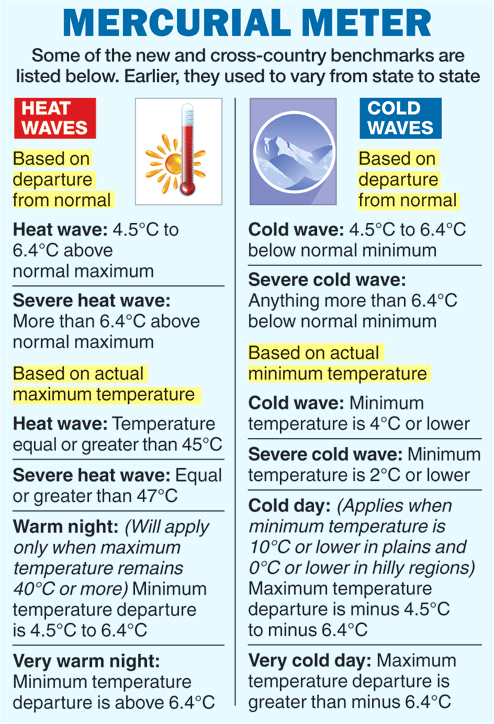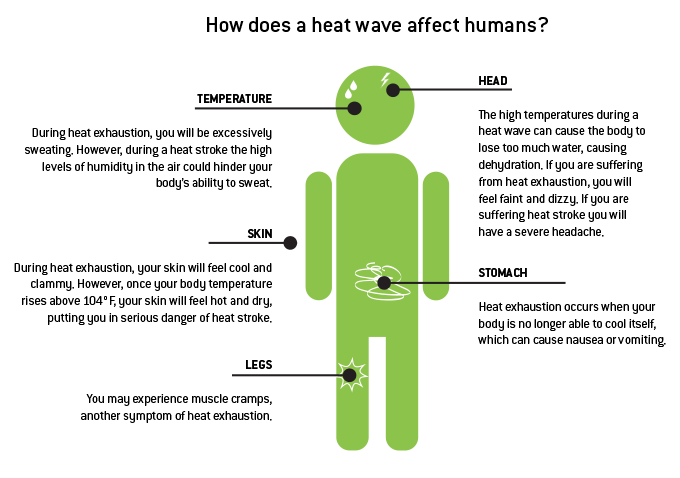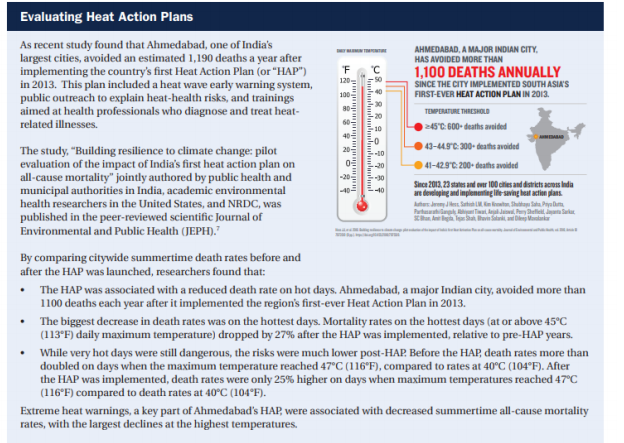
Disclaimer: Copyright infringement not intended.
Context
Last month, France was blistered again, by a spring heat wave that also affected Spain, Italy and other countries. Then, this month, Poland and other parts of Eastern Europe suffered during a spell of extreme heat.
Heat waves in Europe
- Heat waves in Europe, are increasing in frequency and intensity at a faster rate than almost any other part of the planet, including the Western United States.
Why is this happening?
- Global warming plays a role, as it does in heat waves around the world, because temperatures are on average about 1.1 degrees Celsius higher than they were in the late 19th century, before emissions of carbon dioxide and other heat-trapping gases became widespread. So, extreme heat takes off from a higher starting point.
- But beyond that, there are other factors, some involving the circulation of the atmosphere and the ocean, that may make Europe a heat wave hot spot.
- Warming in the Arctic, which is occurring much faster than other parts of the world, may play a role. As the Arctic warms at a faster rate, the temperature differential between it and the equator decreases. This leads to a decrease in summertime winds, which has the effect of making weather systems linger for longer.
- There are also indications that changes in one of the world’s major ocean currents, the Atlantic Meridional Overturning Circulation, may affect Europe’s climate.
- A weakening of the current as the world warmed would cause changes in atmospheric circulation leading to drier summers in Europe.
What is a Heat Wave?
- A heat wave is a period of abnormally and uncomfortably hot and usually humid weather.
- According to the World Meteorological, a heat wave is when the daily maximum temperature for more than five consecutive days exceeds the average maximum temperature by 9 degrees Fahrenheit.
Heat wave Criteria:

- In India, Heat wave is considered if maximum temperature of a station reaches atleast 40 degree C or more for Plains and at least 30 degree C or more for Hilly regions.
a) Based on Departure from Normal
Heat Wave:Departure from normal is 4.5 degree C to 6.4 degree C
Severe Heat Wave: Departure from normal is >6.4 degree C
b) Based on Actual Maximum Temperature
Heat Wave: When actual maximum temperature ≥ 45 degree C
Severe Heat Wave: When actual maximum temperature ≥47 degree C
c) Warm Night
It should be considered only when maximum temperature remains 40 degree C or more. It
may be defined based on departures or actual minimum temperatures as follows:
Warm night: minimum temperature departure is 4.5 degree C to 6.4 degree C
Very warm night: minimum temperature departure is >6.4 degree C
d) Criteria for describing Heat Wave for coastal stations
When maximum temperature departure is 4.5 degree C or more from normal, Heat Wave may be declared provided actual maximum temperature is 37 degree C or more.
How do heat waves form?
- A heat wave is formed when static high pressure generated in the upper atmosphere over a region for several days up to several weeks.
- This static high pressure generates a hot mass of air, which is stagnant for many days and week, which resulted the trapping of more heat that also reduce the convention currents.
- The high pressure acts as a barrier and forces the mass of air to sink to the surface of the land that prevents heat to rise.
- This hot mass of air accumulates only heat and humidity without any trace of precipitation that causes abnormally high temperatures. It is very often during the summer season, from May to November in the northern hemisphere.
- The seal keeps out convection currents that form clouds and eventually rain clouds, both of which would help the area affected cool off.
- Instead the result is a heat wave that has both high heat and high humidity near the ground.
- These heat waves can last from days to weeks.

Implications of Heat Waves
Social impacts
- Extreme heat can lead to heat-related illness and death, particularly in elderly populations, the poor, outdoor workers, and in urban areas.
- Heat waves exacerbate the urban heat island effects, amplifying temperatures in built environments, and resulting in poorer air quality due to the creation of ozone that negatively impacts health.
- Heat-related mortality is expected to be higher in cities, particularly those characterized by high population density, inequalities, limited access to health care, high pollution levels and fewer green spaces.
Economic impacts
- Multiple areas of the economic sector experience reduced worker productivity during heatwaves, especially agriculture and construction.
- Globally, 2% of total working hours is projected to be lost every year, either because it is too hot to work or because workers have to work at a slower pace.
- Lost productivity from heat stress at work, particularly in developing countries, is expected to be valued at $4.2 trillion dollars per year by 2030, driving more inequality.
- The agricultural sector, where 940 million people earn their livelihood, is set to be harder hit by hotter temperatures, pushing workers, crops and livestock past their physiological heat and drought tolerances.
- This will result in lost labour, in smaller harvests for farmers, higher prices for consumers, and negative impacts on livelihoods.
- A World Bank report suggests that by 2050, about 600 million Indians will live in places that could experience loss of living standards, which could cost 2.8% of the GDP, stalling efforts to pull large parts of the population out of poverty.
- Increasing energy demand for cooling also comes as an extensive economic cost to residents, businesses, and governments.
- With these extreme heat events, the need for access to cooling should be viewed as a basic necessity – not just for health and productivity reasons but, in some cases, even for survival.
Ecological impacts
- Heatwaves, without concomitant increases in precipitation, can lead to water shortages and increased stress for plants, particularly in arid regions.
- This has the effect of reducing plant growth, the basis of energy production and the food chain, with an overall drying-out of the landscape.
- For example, the 2003 European heatwave resulted in a 10% loss in glacier mass in Europe, which was five-times more than the average annual loss.
- Similar impacts were reported for the French Alps in 2019.
- Over time, such deep permafrost warming and thawing could cause landslides and rock falls, continuing the negative ecological impacts.
How long can a heatwave spell last?
- A heatwave spell generally lasts for a minimum of four days.
- On some occasions, it can extend up to seven or ten days.
- The longest recorded heatwave spell, in recent years, was between 18 – 31 May 2015.
- This spell had severely affected parts of West Bengal along with Odisha, Andhra Pradesh, and Telangana.
- A similar spell in 2014 was reported during June 2 – June 11.
Does all of India experience heat wave conditions?
- Heatwaves are common over the Core Heatwave Zone (CHZ) — Rajasthan, Punjab, Haryana, Chandigarh, Delhi, West Madhya Pradesh, Uttar Pradesh, Chhattisgarh, Orissa, Vidarbha in Maharashtra, parts of Gangetic West Bengal, Coastal Andhra Pradesh and Telangana, as categorised by India Meteorological Department.
- Several recent studies indicate that CHZ experience more than six heatwave days per year during these four months.
- Many places in the northwest and cities along southeastern coast report eight heatwave days per season.
- However, the regions in the extreme north, northeast and southwestern India are lesser prone to heatwaves.
|
MoES Report
The “Assessment of Climate Change over the Indian Region” Report prepared by the Union Ministry of Earth Sciences has cautioned that by the end of 2100, the “frequency of summer [April–June] heat waves over India is projected to be three to four times higher” and the “average duration of heatwave events is also projected to approximately double.”
The impact of heatwave stress is expected across India but particularly over the densely populated Indo-Gangetic river basin.
IPCC Report
According to The Intergovernmental Panel on Climate Change (IPCC Special Report on Oceans and Cryosphere in a Changing Climate) India will witness marine heat waves, extreme El Niños, and extremely severe cyclones in response to increasing carbon emissions due to continued burning of fossil fuels
|
Heatwave levels
- Heatwave warning levels and the vigilance required are assigned colours — Yellow (level 2), Orange (level 3) and Red (level 4).
- These heatwave warning levels are forecast based on weather forecasts, complemented to a frequency analysis of 30 years of data on mortality rate with weather indicators.
- The information provided by health services are also a part of the forecasts.

https://indianexpress.com/article/explained/why-europe-is-becoming-a-heat-wave-hot-spot-8037899/
1.png)














